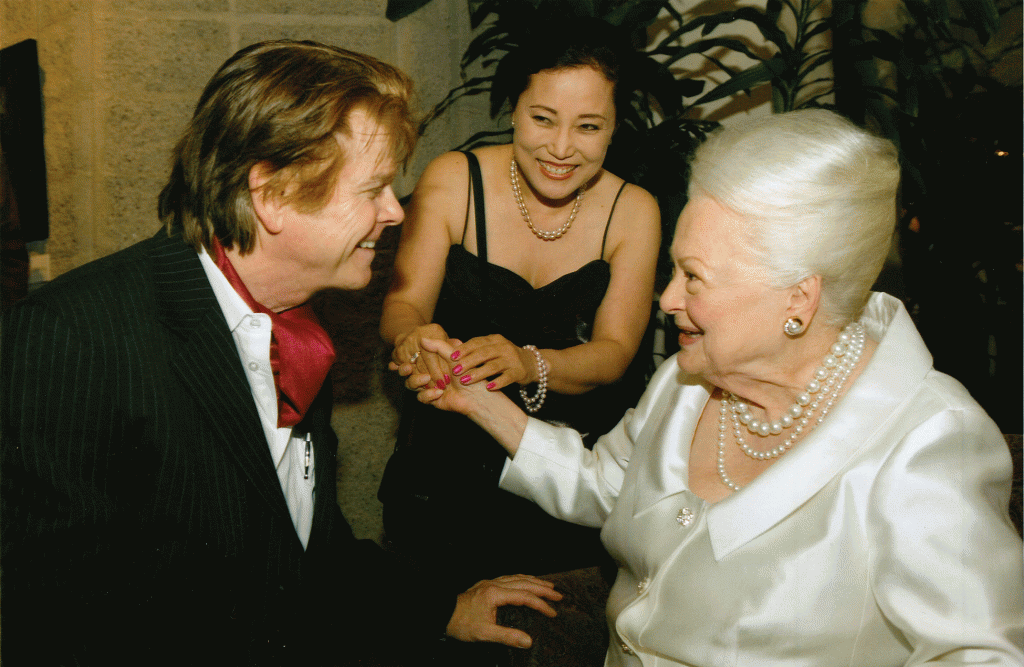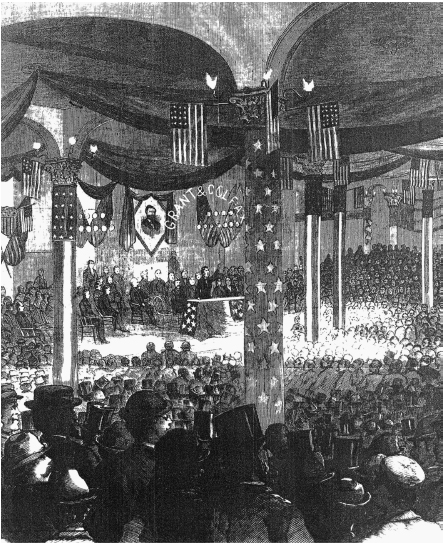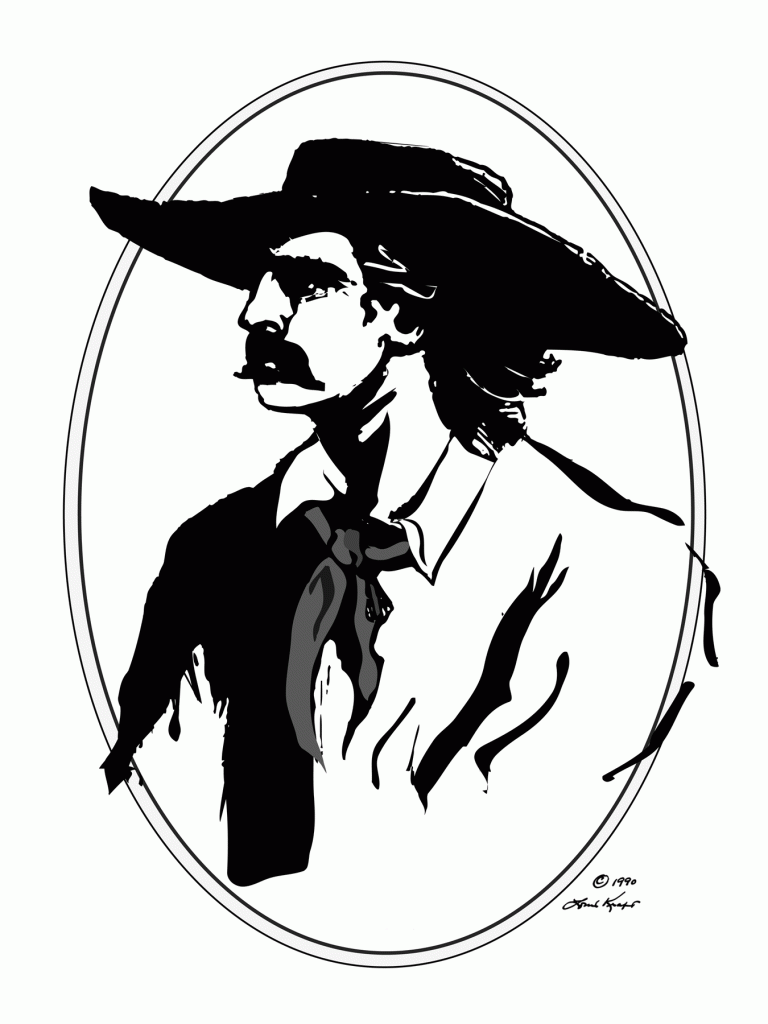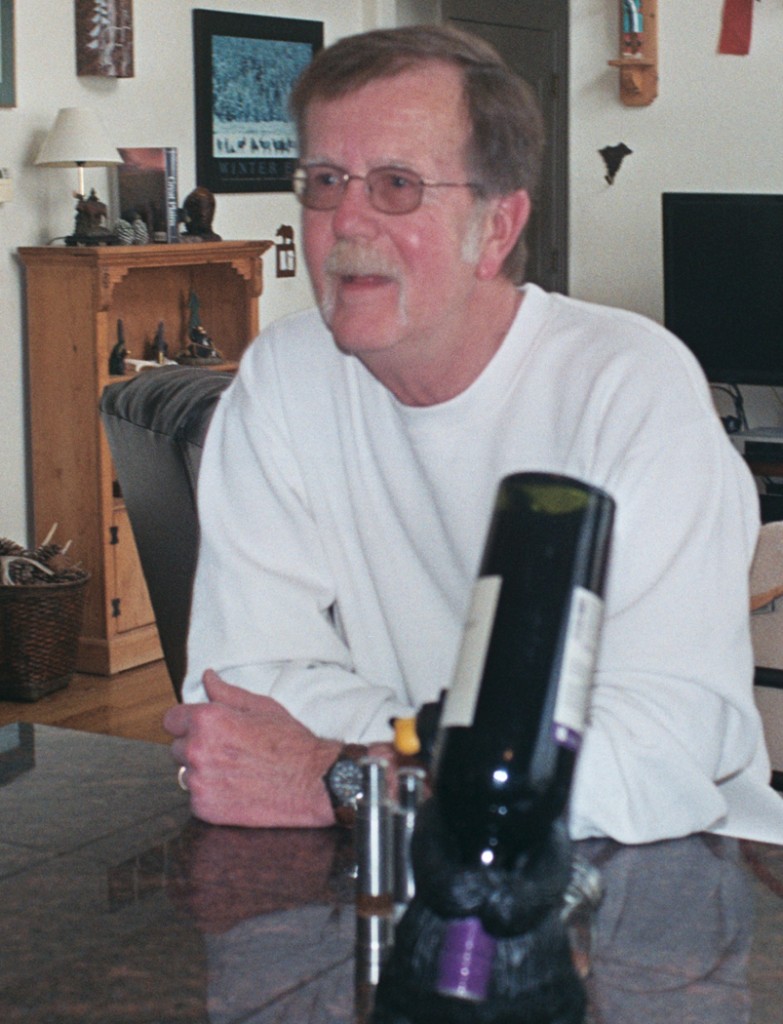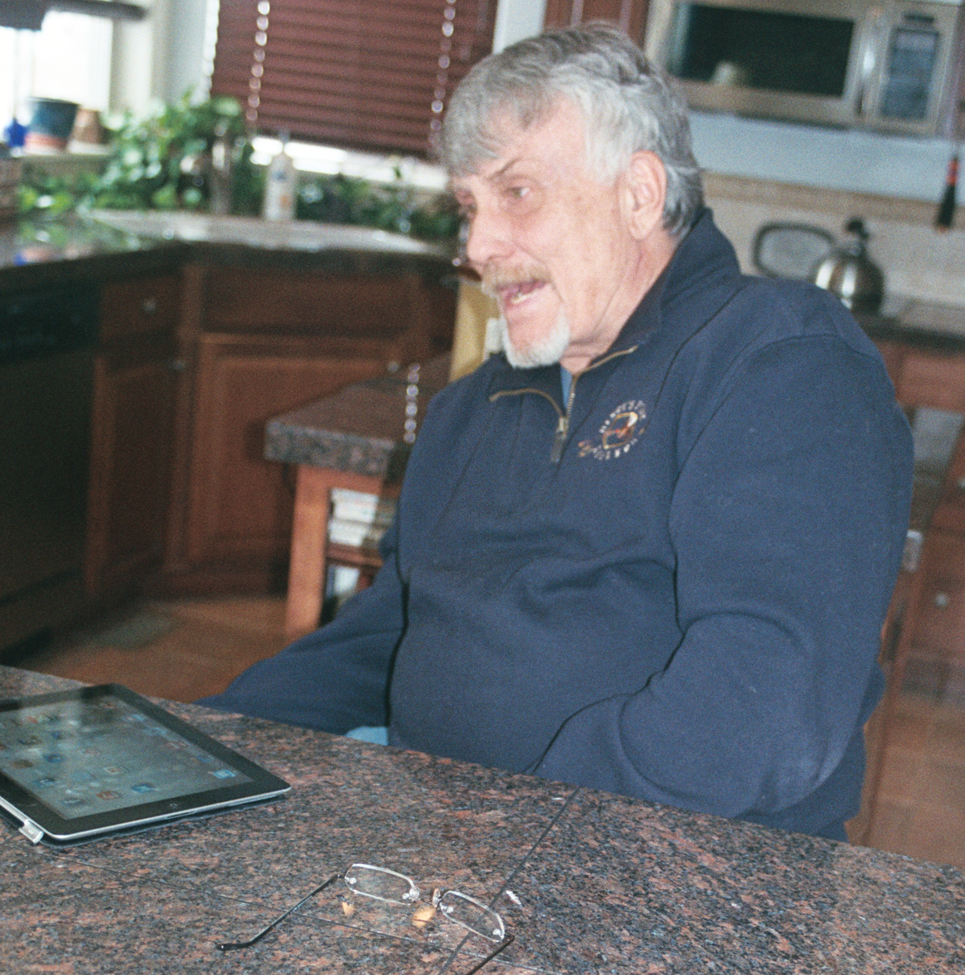Website & blogs © Louis Kraft 2013-2020
Contact Kraft at writerkraft@gmail.com or comment at the end of the blog
I’m certain that some of you are fearful that Errol & Olivia (E&O) has fallen between the cracks as I figure out how to survive in the wondrous city of Los Angeles. I like a number of fantastic areas in our great country—New Mexico and Colorado (minus the snow) are front and center—but it is damned hard to know LA as I have for almost a lifetime and not thrill over all it has to offer.
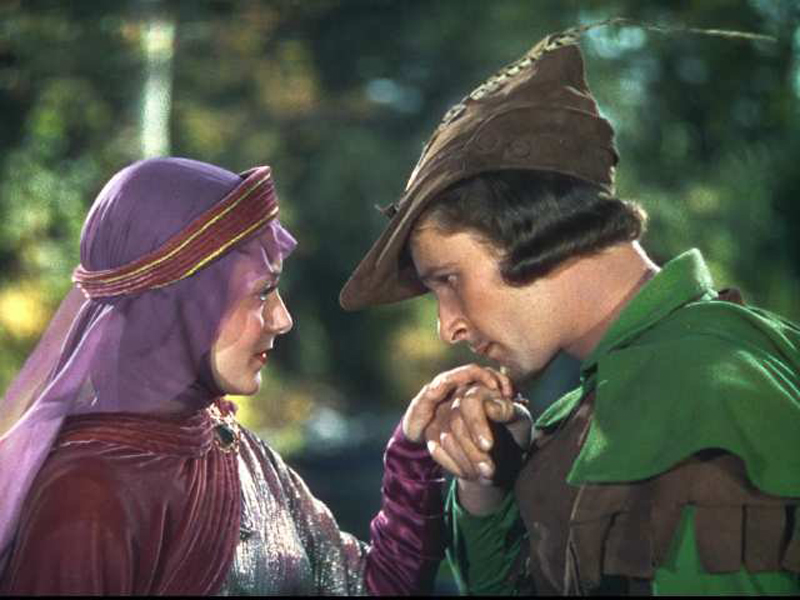
This image captures the beginnings of romance in The Adventures of Robin Hood (1938). The scene happens after Robin (Errol Flynn) has shown Maid Marian (Olivia de Havilland), who is his prisoner, why he has become an outlaw. It has shocked her, and has opened the door for a major change in her life. I hope this image has caught your attention. If so, read on, for I will share some thoughts about the film below. (Louis Kraft personal collection)
We can talk about the weather, theater, restaurants, culture, and on and on and on, … but it is the people. People make our world move forward and thrive, and in LA we have it all—people wise. Everywhere, people, just people—all colors and races. LA is truly a melting pot, truly a microcosm of what our great country is based upon.
Last night I again saw people from all walks of life as I ventured into Hollywood to view The Adventures of Robin Hood (released 75 years ago this month) at the Egyptian Theatre. I sat the best seats in the house. I don’t have any recent photos here to share (my camera is a dinosaur, and I didn’t shoot an entire roll last night), but soon (I promise). My ongoing project, Errol & Olivia, has moved beyond the ongoing search for two people and their place in time (Flynn & de Havilland). Now, if I could only add a small friend to the mix.
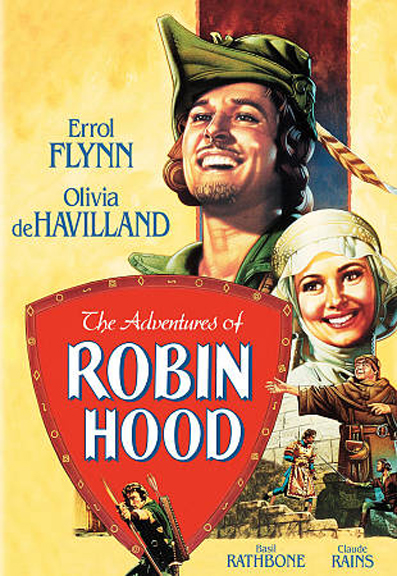
Film cover art that was originally created for a video cover, and which has since been used on DVD covers. If has also been printed as a one-sheet at least once. (Louis Kraft personal collection)
Whenever I view a Flynn, de Havilland, or for E&O, a Flynn/de Havilland film, it is, of course, for enjoyment, but now more importantly it is for critical review. Simply put, what do I like and what don’t I like. Or, said another way, what works on screen and what doesn’t work on screen. All my book projects are long to reach publication (I began researching Ned Wynkoop and the Lonely Road from Sand Creek in the mid-1980s), and there is a reason for this, my reason. I need to discover the person or people I’m writing about. I must discover them, and it cannot be based upon secondary writing that may or may not be error–riddled. (That said, there are some damn good secondary books that are trust worthy, and which I cherish. Thomas McNulty’s Errol Flynn: The Life and Career, McFarland & Company, Inc., Publishers, 2004, is one such book.) Each subject has its own built–in pools of quicksand that can quickly kill a book. Of course the general reader may not see the errors, which in turn makes them “truth.” This sentence is key to my writing world, or saying the words differently: this is what drives me, … how to find what is hopefully the “truth,” clean, as much as possible, from errors. Errors can happen, depending what is found in the research and how it is interpreted. Sometimes a key piece of information isn’t found, and its absence can lead to a conclusion that isn’t true.
Those of you who think that I’ll never complete Errol & Olivia, rest assured, for it will see print. Patience is the key. Beginning on May 22, research again resumes at the Warner Bros. Archives, and the project will again consume two–three days per week of my time. Since Sand Creek and the Tragic End of a Lifeway will soon have a three–year delivery deadline, it is safe to say that E&O will dominate a good portion of my time each week except when I’m on the road (no projected trips until September for a Gatewood & Geronimo talk in Tucson and beyond). Progress will make large jumps this year.
Trust me.
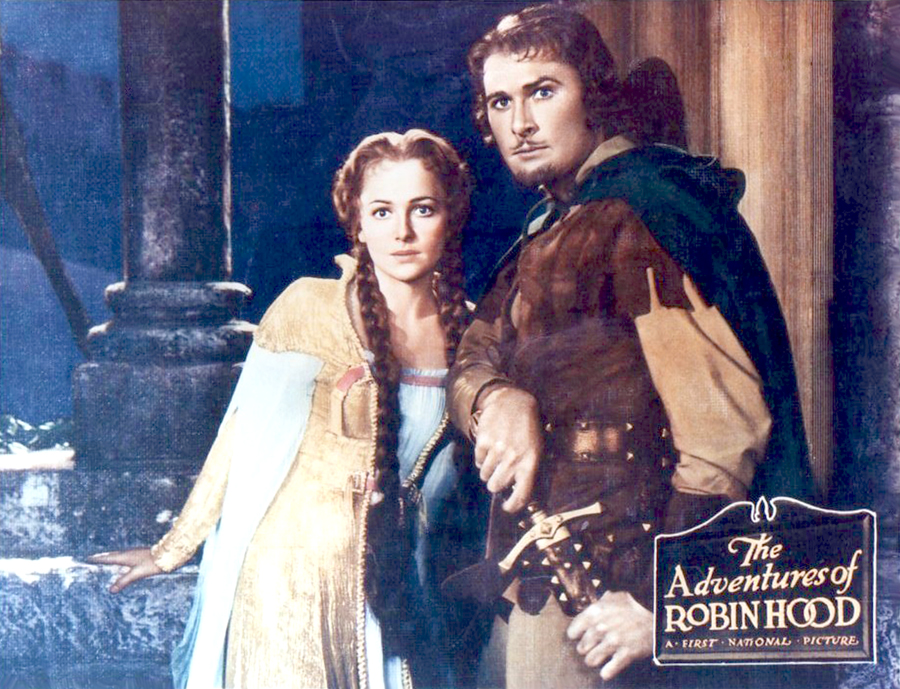
Lobby card (1938) depicting a tense moment after Robin Hood climbs into Maid Marian’s room to thank her for saving his life, and it grows to more, much more. This scene, along with almost all the scenes in the film, is memorable.
Back to Robin and Marian (E&O), … Errol and Olivia certainly share some magical moments on screen, but last night it was Olivia’s performance that grabbed me and didn’t let go.
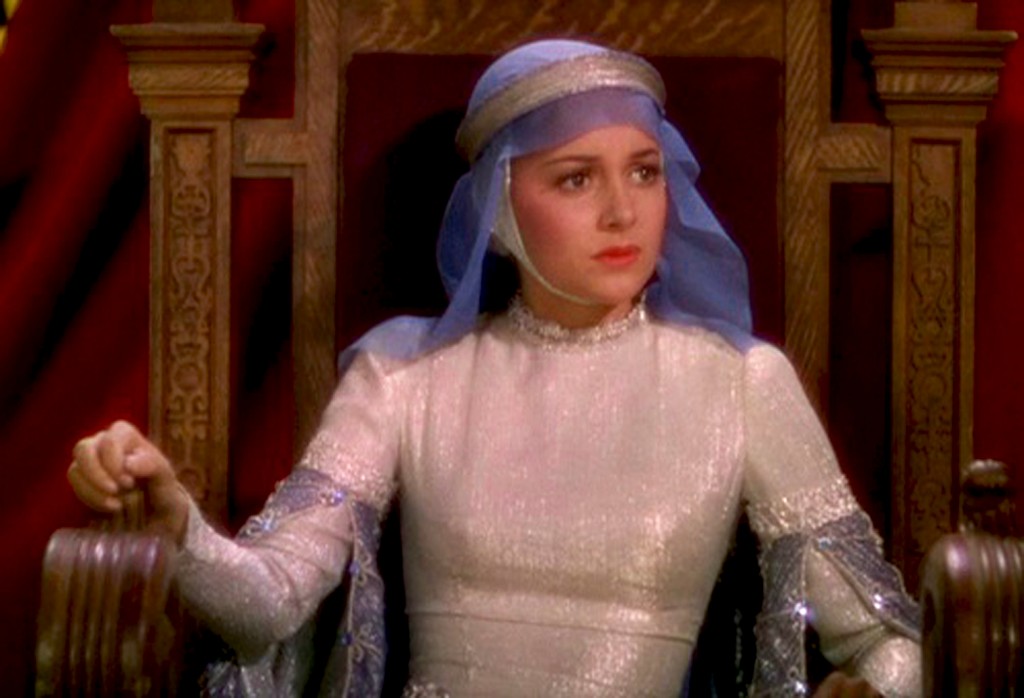
Eyes have so much to do with film acting, and Olivia’s eyes are alive, and offer an entry into Maid Marian’s inner being. (Louis Kraft personal collection)
It’s always good to have time pass before studying a film again, especially when writing about that film. Livvie’s (as she was sometimes called by Errol and others) character development is a wonder to see in the film. The balcony scene, always a favorite of mine, does have a few blips in it, but these were/are director problems; film angles/cuts that pull the viewer right out of the scene. Executive producer Hal Wallis should have jumped on them, and insisted that they be reshot, even though there had been a change of directors. … Over the years Wallis has picked on de Havilland, and often rightly so, but her Maid Marian is one of the acting delights of the film (and there are many … Flynn, Basil Rathbone, Claude Rains, Alan Hale, and on and on). Her performance is a thoughtful growth from a young woman, who at first refuses to accept that the world she knows is corrupt, into a woman that has fallen into love, which in turn instills her with courage to do what she must. There is an eroticism to her performance, that only last night grabbed my attention.
Oh yeah, research and understanding go hand-in-hand, and they are ever changing.
Those of you who know me, know that I like blades, especially swords. The final duel in Robin Hood between Errol Flynn and Basil Rathbone (Sir Guy of Gisbourne) is a wonder, and the reason is multi-faceted, beginning with Flynn and Rathbone’s preparation long before the fight was filmed.
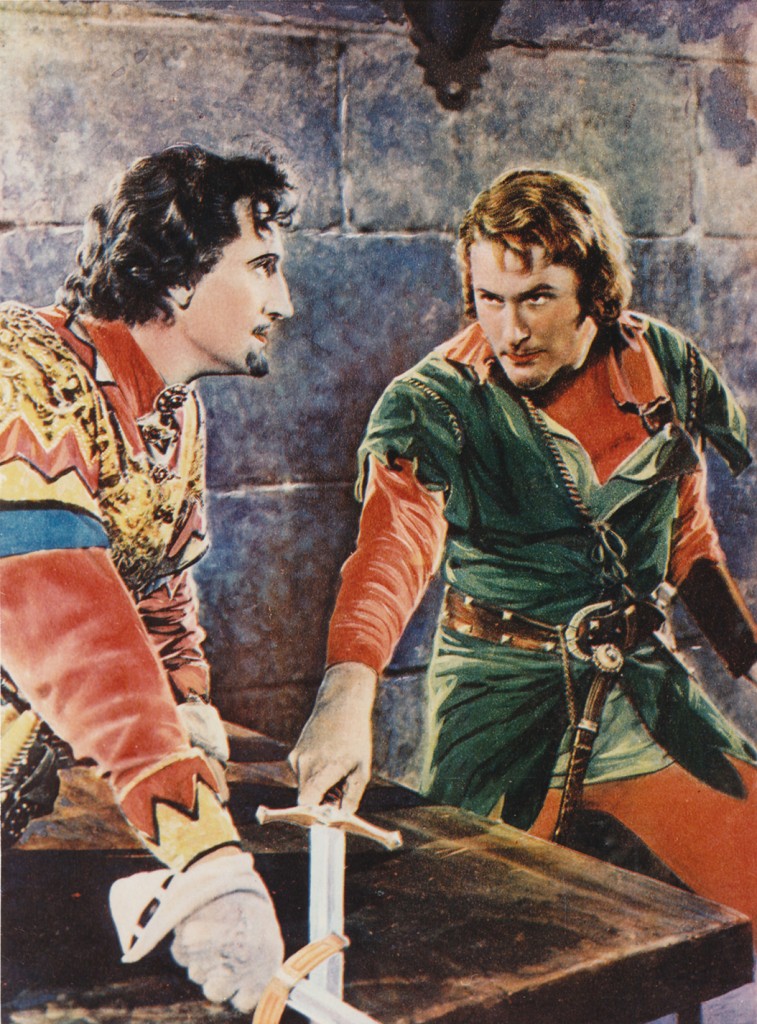
Artwork created from a photo taken during filming. It has appeared in at least one book and has been a magazine cover. (Louis Kraft personal collection)
Sword fights, just like dance, are by the numbers. Everyone knows exactly what the other person is (or people are) doing at all times. If not, a sword fight can quickly spiral toward disaster with someone being hurt (I almost lost an eye once; and I wasn’t a happy camper). It takes a long time to choreograph a duel, with creativity being the key (BTW, it is impossible to duel with broadswords as they did in Robin Hood, but in my humble opinion if the fight had been true to the broadsword, the climatic duel would have been dull or worse, boring). Flynn and Rathbone are never boring in this duel—never, for the duel is a cinematic triumph of dramatic action, and it set the meter of excellence in which all future swashbuckling duels would be compared. It started with fencing master Fred Cavens, who worked with Flynn and Rathbone, and who designed the fight. But it is much-much more, and all of the pieces are intricate and mandatory for a duel to reach full potential on film, and include camera angles and framing, lighting, and editing. These elements take life during filming when the choreographer (fencing master Cavens) works with the actors (Flynn and Rathbone), the director (Michael Curtiz), and the cinematographer (Sol Polito), who in turn works closely with the film crew (lighting technicians, and so on) to create the vision that director Curtiz desires. After the film is in the can (developed and printed), the editor (Ralph Dawson) takes over, but under the keen eyes of executive producer Hal Wallis, whose instinctive feel and magical decisions again and again made the Flynn/de Havilland films shine with life and vitality. And you can bet that Mike Curtiz made his view on the editing known, for he shot what he wanted, and would have vocalized what he wanted the audience to experience in the duel.
Rest assured, some of today’s views have already been added to and expanded upon in the manuscript.
A little long, … sorry, but I wanted to share what one portion of research is like (not all takes place in a lonely archive), and how it can add to a writing project. More updates on Errol & Olivia in the future. Promise.

